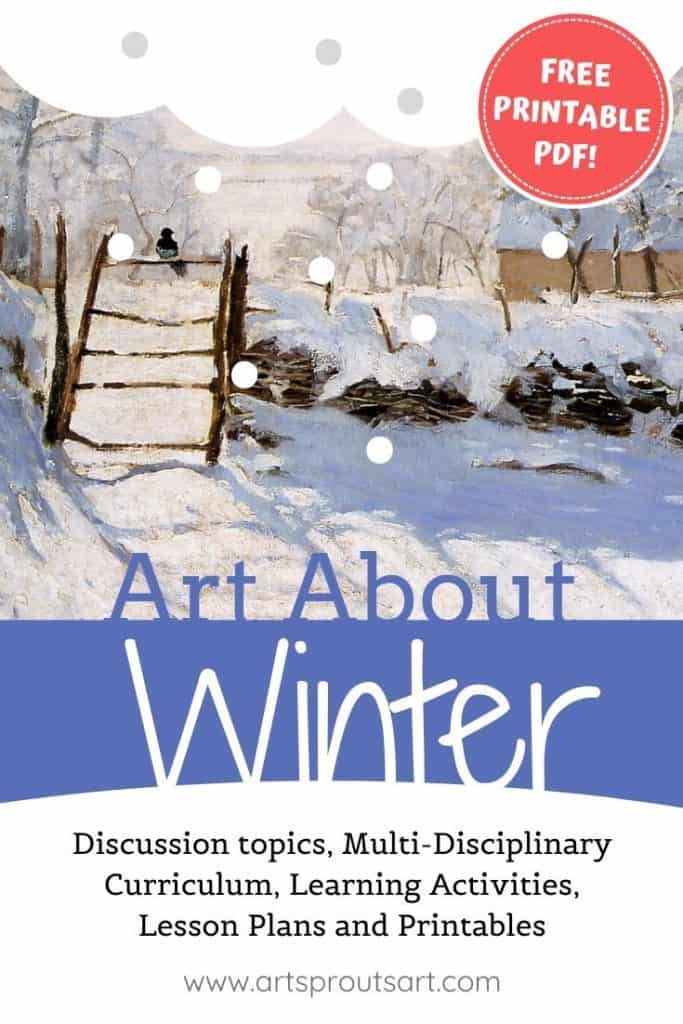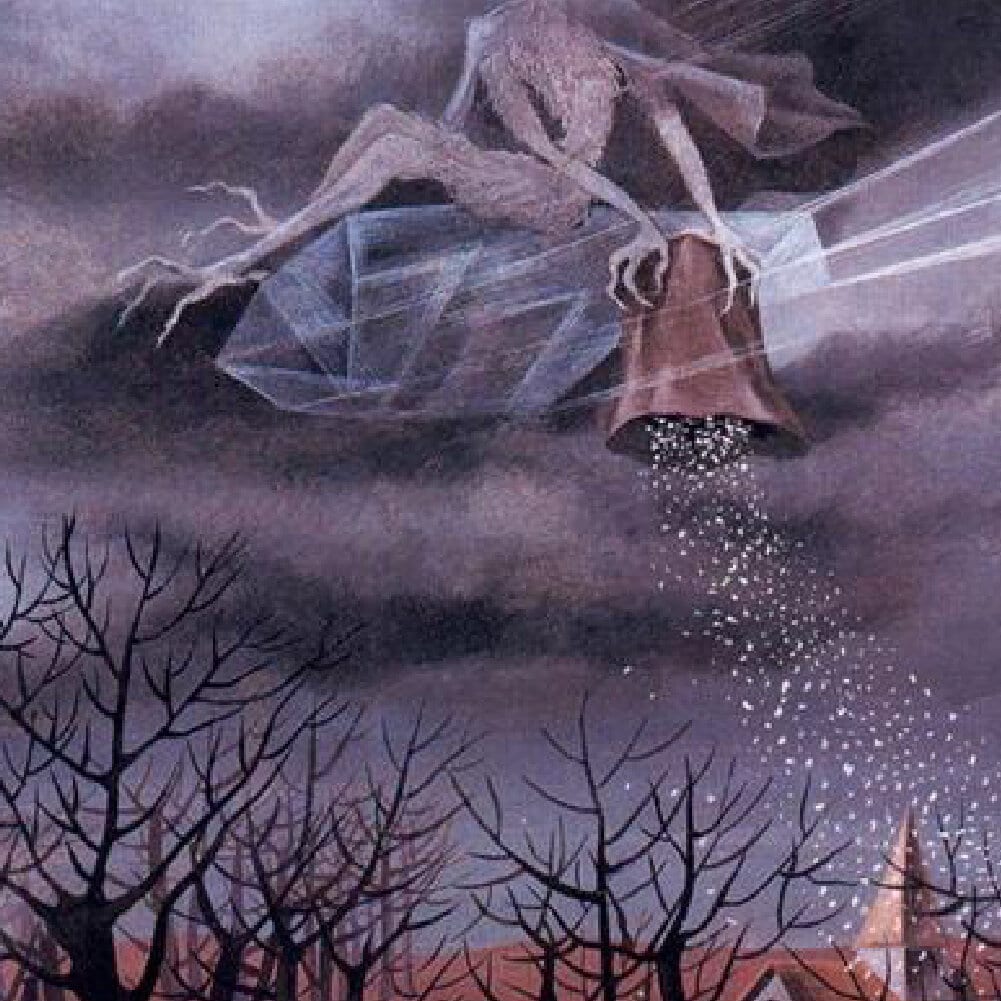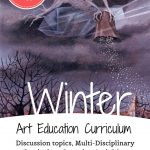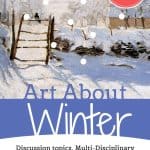Discover the fascinating history of winter paintings in Western Art with this comprehensive winter landscape lesson plan. While snow and winter landscapes may seem commonplace, they were once a rarity in Western art.
This lesson plan will guide students through the social and cultural changes that shaped the depiction of winter scenes in art, from the Middle Ages to Modern times.
Divided into three collections, students will explore iconic winter paintings, domestic life and folklore depictions, and allegorical and symbolic winter scenes in classic and modern art. With this lesson plan, students will gain a deeper understanding of the evolution of winter paintings and the contexts that influenced them.
Introduction
Considering how unexceptional snow is around the northern hemisphere, we are left wondering why are winter paintings actually so rare and sparse in Western art.
True enough, winter landscapes were virtually absent from the arts until the Late Middle Age. What may seem like a simple matter of taste is actually a fascinating and complex account that encompasses climate change, feudalism, international trade, exoticism, all the way to the Industrial Revolution and the republican uprises.
To explore the story of winter paintings in Western Art is to take a journey through the social and cultural changes of Europe from the Middle Age to Modern time.
This lesson plan will curate a selection of artworks into three collections, each with its own focus.
- Firstly, we will delve into the history of winter painting through six emblematic works.
- In the second part, we will examine how artists from different cultures and eras used the challenges of the winter season to depict folklore and domestic life.
- Finally, we will explore some of the allegorical and symbolic depictions of winter, from classic to modern art.
By the end of this winter landscape lesson plan, students will have a deeper understanding of the evolution of winter paintings in Western Art and the social and cultural contexts that influenced them.

- Introduction
- Download as PDF
- Part 1: The History of Winter Landscape in the Arts
- 1.1 The Medieval tradition of the Labour of Months and Genre Paintings
- Art as social commentary
- 1.2 “Genre Paintings”: Scenes of Rural Life
- 1.3 Winter Leisure during the Little Ice Age
- 1.4 French Realism and the Age of Revolution
- 1.5 Japonisme: Winter Landscape in Asian Art
- 1.6 Impressionists in Winter: the “Snow effect“
- Download as PDF
Part 1: The History of Winter Landscape in the Arts
1.1 The Medieval tradition of the Labour of Months and Genre Paintings
The depiction of winter landscapes in Western art started with the tradition of illuminated manuscripts, particularly the “Labour of Months,” a cycle of twelve illustrations representing social life, agricultural tasks, seasonal landscapes, and traditions for each month. One of the earliest depictions of snow in Western art can be found in the illuminated manuscript, “The Very Rich Hours of the Duke of Berry,” painted by the Limbourg brothers around 1412-1416 and one of the most important and best-surviving examples of French Gothic illuminated manuscript.
Limbourg brothers, “Facsimile of February: Farmyard Scene with Peasants”, 1412-1416
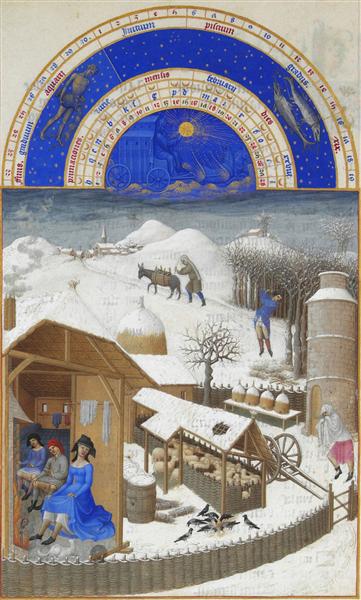
What is an illuminated manuscript?
An illuminated manuscript is a text with graphic decorations such as initials, decorated margins, and illustrations, often containing silver and gold foil, hence the “illuminated” designation.
The earliest surviving illuminated manuscripts come from monasteries in the Eastern Roman Empire and the Ostrogoths Kingdom around 400 and 600 AD. Besides Christian text, monks used to illuminate text from the Greek and Roman era; had it not been for their work, most of the knowledge about ancient literature would have been lost, as the ruling class at the time was no longer literate.
Art as social commentary
“February Page” will never fail to make students (and adults) giggle: at a closer look, you’ll be quick to notice a couple warming their bits by the stove.
Obviously, we are left with questions.
Why? How was that appropriate for a liturgic book? Why was the Duke inserting some suggestive innuendo into his prayer book?
Surprisingly, it has little to do with erotism and a whole lot to do with classism.
The Book of Hours, in which the “February Page” is found, was not public but rather a commissioned manuscript for the Duke’s personal use. As a result, it was not subject to the same political correctness standards as public art, and was filled with derogatory representations of the rural population as unintelligent, primitive, and crass. This biased opinion reflects the aristocrats’ biased opinion on peasants; surely, no ladies or lords would ever be caught in such abysmal conduct!
Once we get past the giggles, discussing these dynamics can actually help students read beyond the depicted image, and understand how commissioners and cultural perspectives influence the final representation. It is also an excellent opportunity to open up a conversation about prejudice and misrepresentation of oppressed groups.
So next time you come across a piece of art that seems questionable, take a closer look and consider the context in which it was created. You may be surprised at what you discover!
RESOURCES:
- Peasants and their role in rural life on the British Library
- Literature, music and illuminated manuscripts on the British Library
- Limbourg brothers, Très Riches Heures du Duc de Berry on Khan Academy
- Digging Deeper: Making Manuscripts, Stanford.edu
MULTIDISCIPLINARY INQUIRY:
- VISUAL ART: How Illuminated Manuscripts Were Created During the Middle Ages at My Modern Met
- NATURAL SCIENCE: The harvest calendar
- ASTRONOMY: Constellations and the changing sky
1.2 “Genre Paintings”: Scenes of Rural Life
Depiction of snow eventually became a recurring theme in Western art as temperatures dropped during what is today known as the Little Ice Age, which lasted from 1300 to 1850.
One of the first winter paintings in Western art is The Hunters in the Snow, painted by Pieter Bruegel the Elder in 1565 as part of The Months of the Year Cycle. Representing rural life through the seasons, The Hunters in the Snow falls under the Medieval tradition of the Labour of the Months.
The winter of 1565 was so harsh, it changed the course of European art. From then on, snow-covered landscapes became a recurring theme in the works Bruegel. Even when painting biblical scenes, such as The Adoration of the Magi (1567) or The Census at Bethlehem (1566), Bruegel incorporated the wintry landscapes that had come to define his art.
Pieter Bruegel the Elder, “Hunters in the Snow”, 1565
Pieter Bruegel the Elder’s Hunters in the Snow depicts a harsh winter landscape, where peasants are shown playing and skating in the background while hunters struggle to capture a fox and hare with large spears. Women prepare a large pit for the roast, but the St. Hubert’s signage, protector of the hunters, is about to fall into the fire. Despite the apparent joyfulness of the peasants, the painting reflects the hardship and uncertainty of survival in rural life. This painting was part of a cycle of at least six paintings, and it also shares the balcony motif typical of Flemish painting, with a hill on the foreground that offers a vantage point to the subsequent landscape.
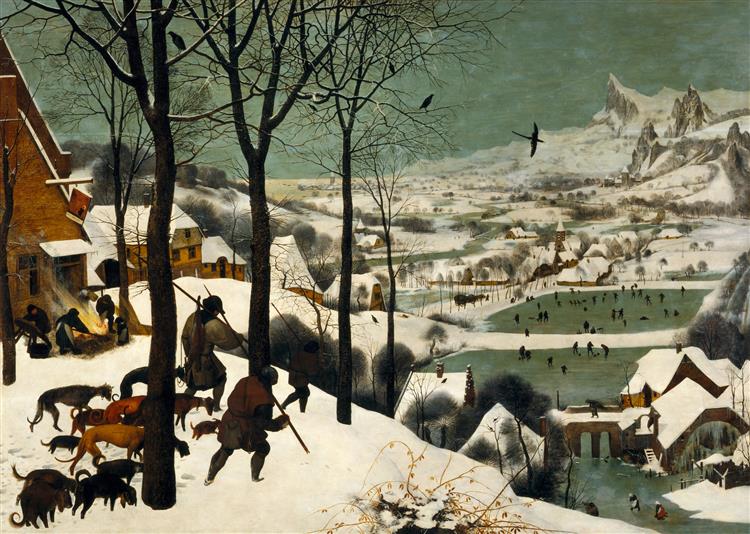
The subtle irony of Peasant-Bruegel
Bruegel’s portrayal of rural life was different from that of painters like the Lambourg brothers. He gave peasants agency and showed them sharing the same burden, resulting in a compassionate and sympathetic portrait. This honest, empathetic, and humorous style of capturing everyday life generated a new style in art called “genre painting,” which eventually evolved into the Realism movement.
CLASS ACTIVITIES:
- “The Hunters in the Snow”, Find the detail, observational game
- Bruegel For Children
RESOURCES:
MULTIDISCIPLINARY INQUIRY:
- SCIENCE: Climate Change: The Little Ice Age Case Study Lesson Plan
- WORLD HISTORY: The Northern Renaissance
1.3 Winter Leisure during the Little Ice Age
During the Little Ice Age, the cold climate transformed the natural and cultural landscape of Europe. The advancing glaciers engulfed Alpine villages, while frozen rivers and seas isolated entire countries in Northern Europe. The harsh weather led to recurring famines, causing the death of about one-tenth of the European population. The landscape was also altered as snow covered the ground for many months each year, while large rivers and lakes would freeze over.
The River Theme Frost Fair was a festive distraction during the coldest winters, where the Theme would freeze over. The first fair took place in 1408, and the last was held in 1814. Shops were built on the ice, and recreational activities and sports took place, making it a sort of “Carnival of winter.”
Hendrick Avercamp, “Winter Landscape with Ice Skaters”
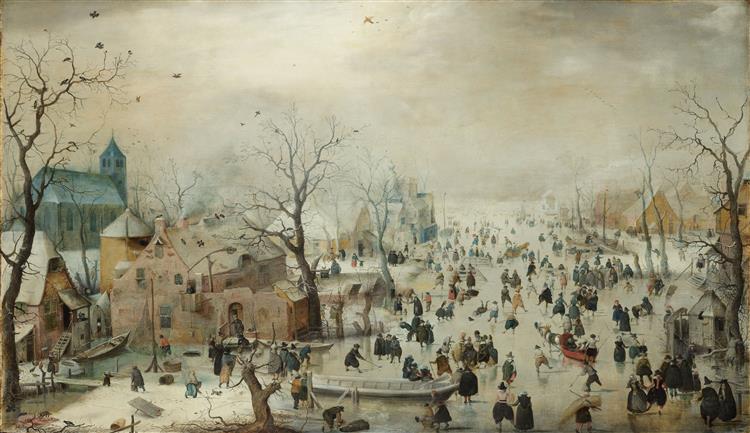
Hendrick Avercamp, a Dutch painter who lived during some of the coldest years of the Little Ice Age, frequently painted scenes of winter. His childhood memories of skating on frozen lakes became one of his most recurring themes. During the severe winters, lively scenes became a way to escape the cold and hunger that were affecting the population.
CLASS ACTIVITIES:
- 7th Grade: “Winter Landscape with Skaters” Lesson Plan PDF
- Explore “A Scene on the Ice” Lesson Plan PDF, National Gallery of Art
RESOURCES:
- Museum of London: All the Fun of the Frost Fair
- A Climate of Change, How the Little Ice Age ushered in the modern world.
MULTIDISCIPLINARY INQUIRY:
- ART HISTORY: Painting in the Dutch Golden Age PDF, National Gallery of Art
1.4 French Realism and the Age of Revolution
In the 19th Century, artists increasingly found their subject matter in everyday life as religious and historical paintings declined. “Genre paintings,” also called petit genre, depicted aspects of daily life by showing figures with no specific identity engaged in mundane activities. The shift in figurative art followed the political changes that were taking place in Europe at the time, informally known as the Age of Revolution, which saw the abolition or reform of several European monarchies.
Realist painters in particular blurred the line between high art and “minor” subject matters, putting nameless farmers and workers at the center of their art, a place traditionally held by religious or political figures. For the first time, ordinary people were represented in mainstream art with realistic urgency, without glorification or allegory. Realism is broadly considered the beginning of Modern art as it abandoned symbolic representation for truthful exploration of all aspects of reality and human experience.
Gustave Courbet, Poor Woman of the Village
Gustave Courbet, a Realist painter, painted numerous winter scenes, including animals, farmers, hunters, and some of the earliest studies on the “snow effect,” the multitude of lights and colors on fresh snow that would fascinate Impressionist artists later on.
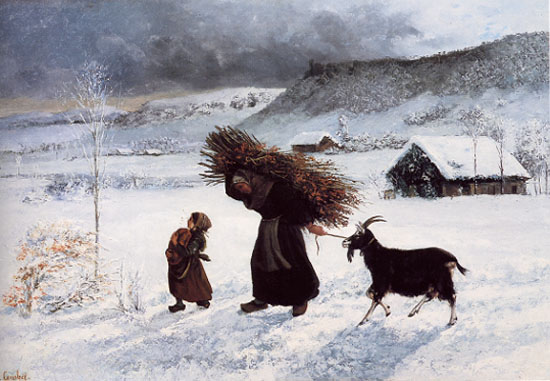
Talking about his art, in 1855 Courbet said, “To know in order to do, that was my idea. To be in a position to translate the customs, the ideas, the appearance of my time, according to my own estimation; to be not only a painter, but a man as well; in short, to create living art – this is my goal.”
RESOURCES:
VIEW ALSO:
MULTI-DISCIPLINARY INQUIRY:
1.5 Japonisme: Winter Landscape in Asian Art
Seasonal elements are a significant theme in Japanese art, reflecting the native Japanese belief known as Shinto. Shintoism believes that divinity (Kami) is present in Nature itself, while anthropomorphic representations of Gods began only after the arrival of Buddhism from neighboring China.
The observation of nature and changing seasons is thus deeply connected with reflecting on the human experience. The relative simplicity of natural landscapes leaves room for meditation on the transience of human existence, and the ephemeral beauty of nature and life (Wabi-Sabi). The sense of melancholy and impermanence of Shinto art comes from cherry blossoms, changing foliage, falling snow, and chrysanthemums flowers.
Evening snow at Kambara, “Fifty-three Stations of the Tōkaidō,” Hiroshige, 1833-34
One of the most famous Japanese artists of the Edo period, Utagawa Hiroshige, traveled along the Tokaido route from the capital to Kyoto in 1832. He used the sketches of travelers and attractions to create one of his most famous series of prints, The Fifty-three Stations of the Tōkaidō. Hiroshige is considered the last grandmaster of the Ukiyo-e tradition, having worked just before the westernization of Japan that followed the Meiji Restoration of 1868.
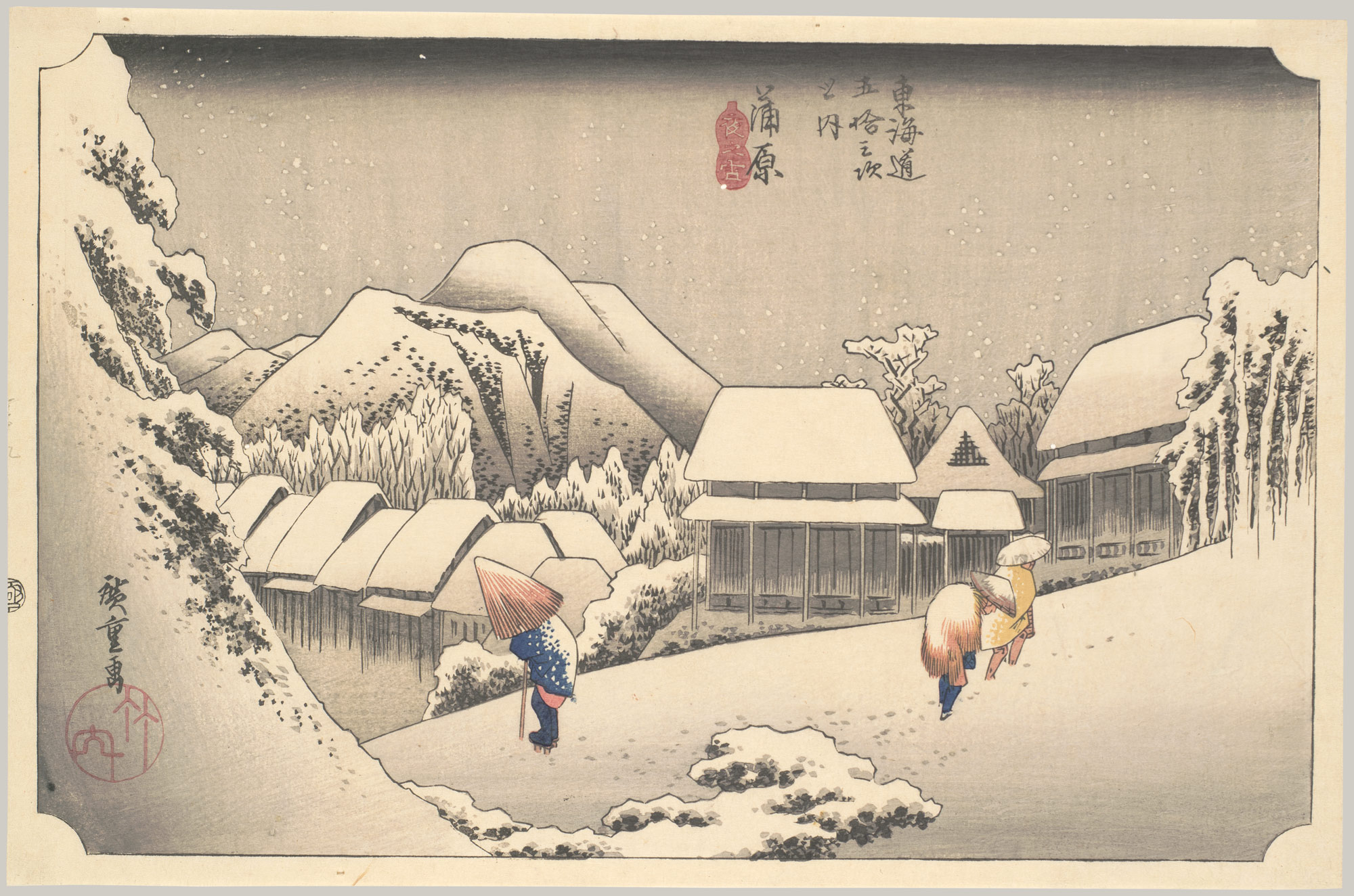
Hiroshige’s works, along with those of Hokusai, were the most traded during the 19th Century Japonisme craze. The novel subject matter, the use of color, and the distinctive elevated vantage point, greatly influenced the work of Impressionist painters. Manet and Monet were both collectors of his prints, while Van Gogh painted popular oil copies of his famous series One Hundred Famous Views of Edo.
What is Ukiyo-e?
Ukiyo-e is an art form that developed in the old capital Edo (modern Tokyo) during the Edo period from the 17th to the 19th Century. The Tokugawa Shogunate that ruled during this time was the last feudal military government ever to rule Japan: during this time, Japan experienced 250 years of stability and economic growth, prompted by a strict isolationist policy and a rigid social order.
The merchant class, although wealthy and economically powerful, was considered exploitative by Confucian standards and was now at the bottom of the new social hierarchy below farmers and artisans. Cut off from political power, merchants looked for ways to show their wealth and culture in the same way upper classes did.
This search for enjoyment became known as Ukiyo 浮世, an ironic allusion to the Buddhist concept of Ukiyo, which describes the transitory illusion of life, also known as the “sorrowful world.” However, during the Edo era, Ukiyo took the more indulgent meaning of “floating world,” referring to the hedonistic, pleasure-seeking attitude of urban lifestyle.
Ukiyo-e, or Pictures of the Floating World, depicted the entertainment districts of Edo, telling stories of Geishas, Kabuki actors, Sumo wrestlers, Samurais, Chonins, prostitutes, and pleasure houses. The woodblock printing technique used to produce Ukiyo-e was invented in China as early as 220 AD, eventually reaching Japan in the 7th century along with Buddhist practices. While early examples of painted Ukiyo-e do exist, the increasing popularity demanded an inexpensive mass-production system such as woodblock printing. It was later in the 1760s that Suzuki Honorubu, one of the most important Ukiyo-e artists, perfected the technique of multi-colored prints.
One of the most recognizable examples of Ukiyo-e art today is The Great Wave off Kanagawa by artist Hokusai. However, it’s important to note that landscape scenes, which dominate the Western perception of Ukiyo-e, were not a traditional subject matter until after the Tenpo Reform in the 1840s. This reform suppressed the outward display of luxury, including depictions of courtesans and actors. The Reform happened just before the forced American opening of the country to foreign trade in 1854, which explains the popularity of landscape scenes in the West compared to the indulgent, traditional subject matter.
Living only for the moment, savouring the moon, the snow, the cherry blossoms, and the maple leaves, singing songs, drinking sake, and diverting oneself just in floating, unconcerned by the prospect of imminent poverty, buoyant and carefree, like a gourd carried along with the river current: this is what we call ukiyo. Asai Ryoi, Ukiyo Monogatari (“Tales of the Floating World,” c. 1661)
Those are the world writer Asai Ryōi uses to describe the Edo idea of ukiyo. It’s interesting to note the shift in philosophy from traditional Shintoism: while the transient property of life remained unmuted, human attitude had evolved from meditation to enjoyment.
It is clear that the hedonistic themes depicted in Ukiyo-e artwork had a strong attraction for Bohemian artists in Europe. Following the Realism movement, Ukiyo-e presented another example of ordinary, everyday life portrayed as it actually was, devoid of any symbolic or political messages.
Japonisme and Exoticism
For over 200 years, trade with Japan had been a Dutch monopoly, entirely controlled by the Dutch East India Company from the Dejima trading post in Nagasaki Bay.
The Dutch were the first Europeans to establish a trade relationship with Japan when they arrived in 1600, and they were allowed to establish a trading post in Dejima in 1641. The island was fan-shaped and separated from Japanese society by an artificial canal, which meant that Dutch traders were limited in their interactions with the Japanese people.
Thanks to their monopoly, the Dutch were the first to receive the few and rare Japanese artifacts. As shipments were expensive and rare (only two boats per year were allowed docking during the 18th Century), most of the trade focused on high-value items such as silk, cotton, porcelain, and lacquerware.
However, there were also some lower-value items that were initially overlooked by the Dutch traders. Among them were ukiyo-e prints, which were cheap, mass-produced items in Japan, used primarily as entertainment. They had so little value that they initially made their way to Europe as packaging material for fragile goods.
Not a style nor a movement, Japonisme is loosely defined as the influence of Japanese art on Western artists, a trend that boomed at the end of the 19th century encompassing all artistic media, from fine arts, to craft, to textile design, to poetry, to literature. Following the first Japanese exhibition at the Paris Exposition Universelle in 1867, shops trading Japanese artifacts popped everywhere in Paris, responding to the new curiosity and appetite for exotic goods.
Among all, Ukiyo-e prints were the most affordable for European artists to purchase: Van Gogh and his brother Theo traded them, eventually collecting hundreds of prints. They appeared in many of his paintings as backgrounds and as direct reference. Painter Degas owned Torii Kiyonaga’s Bathhouse Women Ukiyo-e, which inspired his famous Bathroom series. When Monet died, he left behind a collection of over 230 prints. In fact, Hokusai and Hiroshike’s bridges composition directly inspired the architecture of his lilies garden in Giverny.
At the end of the 19th century, Monet’s body of work best exemplified the changing culture in Europe. Through his work, he perpetuated Courbet’s Realist legacy while developing a radically modern aesthetic inspired and reinforced by Asian art. The influence of Japanese art on Monet’s work can be seen in his use of flattened forms, bright colors, and asymmetrical compositions, all of which were characteristics of ukiyo-e prints. Overall, Japonisme had a significant impact on Western art and culture, influencing not only the visual arts but also literature, fashion, and interior design. Its influence can still be seen today in various forms, and it remains a testament to the power of cross-cultural exchange and the impact of globalization on the arts.
Sources:
- Wichmann, S. (1974). Japonisme: The Japanese Influence on Western Art Since 1858.
- Shimada, R. (2016). The Dutch East India Company and the Rise of Intra-Asian Commerce.
- Van Tilborgh, L. (2008). Vincent van Gogh and the Birth of Japonisme.
- Jill DeVonyal. Degas and the Art of Japan.
- “Japonisme and the Rise of the Modern Art Movement: The Arts of the Meiji Period” by Gregory Irvine
- “The Japanese Print: A Historical Guide” by Hugo Munsterberg
- “Ukiyo-e: The Art of the Japanese Print” by Frederick Harris
RESOURCES:
- Artworks and artists of Ukiyo-e Japanese prints, The Art Story
- Ukiyo-e Art Database
- Art of the Pleasure Quarters and the Ukiyo-e Style, Met Museum
- Impressionism – The Influence of Japonisme
- The Japanese Prints that Inspired Vincent van Gogh, Hyperallergic
- Japponisme Rediscovered, The Khalili Collection, Harvard Art Museums
- Art Nouveau PDF, National Gallery of Art
SEE ALSO:
- Japonism artworks: “Branches with Almond Blossoms” Van Gogh, “La Japonaise” Monet, “Wave” Ertè, “The Seasons” Alphonse Mucha, “Portrait of Émile Zola” Manet, “Divan Japonais” Toulouse-Lautrec, “Lady with Fan” Klimt, “Père Tanguy” VanGogh, “The Bath” Cassatt
MULTI-DISCIPLINARY INQUIRY:
- VISUAL ART: Block Printing for Kids, The Art Class Curator
- SOCIAL STUDIES: Debating Cultural Appropriation in the Art History Classroom
- SOCIAL SCIENCE: Rangaku: Investigation on cross-cultural exchange
- WORLD HISTORY AND CULTURE: Edo Period PDF Lesson Plan, Stanford.edu
- ART HISTORY: Edo Art in Japan, Teaching Program PDF
- PEOPLE IN SOCIETY: Ukiyo-e Japanese Prints Depicting the Floating World Lesson Plan PDF, The Cleveland Museum of Art
- WORLD HISTORY: From the Edo Period to Meiji Restoration in Japan Lesson Plan
1.6 Impressionists in Winter: the “Snow effect“
When it comes to Monet’s winter landscapes, choosing a single artwork to represent his impressive repertoire can be a challenging task. Throughout his career, Monet painted over 140 snowy landscapes! One of his earliest works, The Magpie, stands out as not only one of his most renowned but also a representative of the Realist and Japanese influences that defined his early art.
“The Magpie”, Monet, 1869
“The Magpie,” painted in 1869, while still reminiscent of Courbet’s rural scenes, shows the beginning of Monet’s chromatic journey. We can observe the evolution of Monet’s sensitivity toward light and color by comparing it to his earliest winter landscape, “A Cart on the Snowy Road at Honfleur,” painted only three years earlier. “The Magpie” is much brighter and more vivid, with the sunny snow almost blinding. The illusion of contrast is now achieved by juxtaposing warm and cold hues, rather than with the traditional light/dark monochromatic shading. In fact, the artwork is considered one of the earliest examples of Monet’s colored shadows, an unorthodox technique that would define Impressionism and forever change Modern painting.
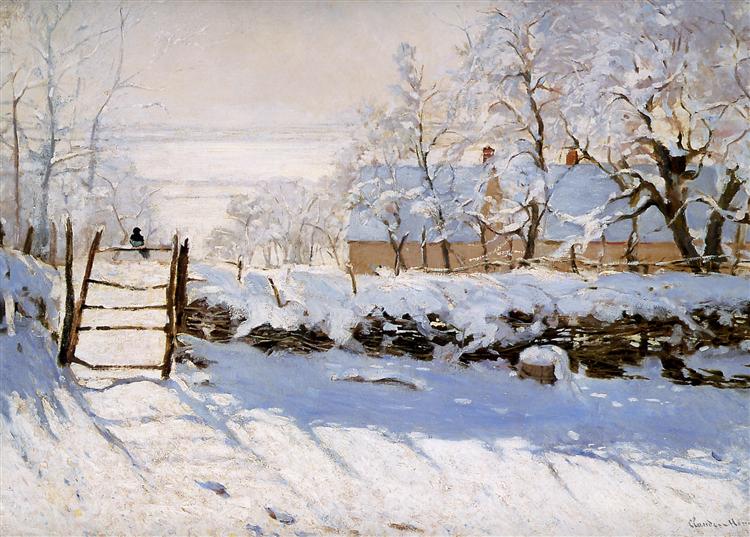
The Impressionists used the whiteness and reflectivity of snowy landscapes to investigate “the problem of shadows,” the way the perception of color changes according to the light condition and the juxtaposed colors. This new approach was inspired by Goethe’s “Theory of Colours” published in 1810, which put forward the possibility of the subjectivity of perception in color theory. During their first-hand outdoor observations, Impressionist artists noted that shadows are not desaturated colors as many painters used to believe: instead, they are a multitude of hues affected by the light and the environment.

IMPRESSIONISM AND THE “PROBLEM OF SHADOWS”
The Impressionists used the whiteness and reflectivity of snowy landscapes to investigate “the problem of shadows,” which is the way the perception of color changes according to light conditions and juxtaposed colors. Impressionist artists were inspired by Goethe’s “Theory of Colours,” which was published in 1810 and put forward the possibility of the subjectivity of perception in color theory. During their first-hand outdoor observations, Impressionist artists noted that shadows are not desaturated colors, as many painters used to believe. Instead, they are a multitude of hues affected by light and the environment.
EFFET DE NEIGE AND OUTDOOR PAINTING
Impressionists advanced their inquiry on colors during long painting sessions en plein air. While it may sound trivial today, outdoor painting was actually challenging if not impossible until tube colors were made readily available by the industrialization process. Ready-made paint freed artists from their studios and allowed for quick, impromptu painting. Monet, Sisley, Pissarro, all spent extensive time outdoor painting winter scenes and perfecting what was called “Effet de Neige,” or snow effect.
It would take three more years after The Magpie was painted for Impressionism to be recognized as a movement and hold its first official exhibition in 1873. As time passed, composition became less and less important, relying almost entirely on colors, which became more and more vivid, using almost pure out-of-the-tube pigments. In Monet’s last Weathstacks in the snow series from 1891, there is almost no white color. The palette changes according to the time of the day, and the main focus is the contrast between the sun’s warmth reflected on the snow and the cold feeling of the blue shadows.
The Impressionists’ snow landscapes are a testament to their skill and innovation in exploring the effects of light and color on perception. Through their en plein air paintingand focus on the nuances of shadow and color, they were able to capture the ephemeral and ever-changing beauty of snowy landscapes in a way that had never been seen before. Their groundbreaking techniques, including the use of colored shadows, the elimination of black paint, and their use of pure, vibrant color, paved the way for future art movements such as Fauvism and Expressionism.
CLASS ACTIVITIES:
CLASS RESOURCES:
- Goethe’s, Theory of Colours, Free Ebook, Google Book
- Khan’s Academy: A Beginner Guide to Impressionism
- A guide to Impressionism, VMFA
- Who is Claude Monet? Tate Kids
MULTI-DISCIPLINARY INQUIRY:
- NATURAL SCIENCE: Color Theory
- NATURAL SCIENCE: 24 Cool Winter Science Experiments, We Are Teachers

What do you think? Was this post useful to you?
Leave a comment below!
If you liked this post you may want join my newsletter and stay up to date!
